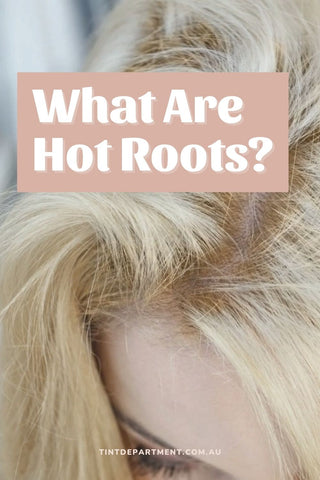
Have you ever looked in the mirror after colouring your hair and been horrified to see bright orange roots?
If that’s you, then your search for answers may have led you to hear about hot roots and you probably desperately wanted to ask a hairdresser what caused them and how to fix them at home, but couldn’t bring yourself to raise your hand.
I get it. In the hair world, getting the information and advice you need (especially when it feels like a crisis) can feel super intimidating and almost impossible.
Today, you’re in luck because I’m going to show you everything you need to know about hot roots but were afraid to ask, including how to fix them and avoid them in the future.
What Are Hot Roots?
In simple terms, hot roots means the roots of your hair are brassy (usually orange) compared to the rest of your hair.. This is a common issue that happens with colouring or toning. You will usually find that hot roots appear on the first few centimetres of your hair, closest to your scalp and you’ll find they look very warm - even bright, bright orange in some cases.
Why Do Hot Roots Happen?
Hot roots happen when the hair at the scalp has not been treated differently to your lengths and ends. You might think you can just colour or tone your hair with one formula and everything will turn out perfectly. However, that’s often not the case!
There’s a few reasons why your roots need to be treated differently than the lengths of your hair - your roots may be darker, they may be lighter and (in all cases) they react differently to colour or toner.
Let’s dive a little more into that last point. The heat from your scalp causes your colour or toner to react to your hair differently than the ends. Also, as the hair at your roots is the newest (and often doesn’t have any previous colour or toner on it) it will also react differently.
Colouring and toning your hair is a chemical process. The heat from your scalp can speed up this process, which can cause some formulas to start to lighten your hair. But (unlike when you bleach your hair) this lightening isn’t strong enough to give you blonde hair, so instead you’re left with bright, brassy hot roots.
How To Fix Hot Roots
So far, we've stayed pretty technical in our exploration of hot roots, and if you're still confused, I don't blame you.
In fact, when I first started learning about the hair colouring process, I felt like I’d never truly get the hang of it. The fact that I am writing to you after helping tens of thousands of women with their hair over the last seven years shows that I was thankfully wrong.
Luckily, everything about hot roots is more complex in theory than in practice.
I've put together a few common scenarios where you’ll deal with hot roots below to help you better understand and (most importantly) fix them yourself - all from the comfort of home.
How To Fix Hot Roots When Your Lengths Are Darker
This one is the easiest fix, so you’re in luck. What you’ll see here is that, after you’ve toned or coloured your hair, your lengths are now left a darker shade and your roots are now orange roots.
To hot roots on darker hair, you will need to re-colour or re-tone your roots. You can do this with the same shade if you like - but you will need to use a lower strength developer. It’s very likely that you used a 20 Vol Developer when you coloured or toned your hair the first time (am I right?). This will have caused your roots to lighten, but not your lengths. So, you will need to use either a 10 or 5 Vol Developer to fix them. Using a lower strength developer will allow your colour or toner to work without lightening and should fix your problem.
You can also go a shade or two darker than your lengths - which is a look I love as it gives a more natural effect. Again, use a 10 or 5 Vol Developer at the roots.

How To Fix Hot Roots When Your Lengths Are Lighter
You have two main options when you find yourself with hot roots and lighter ends.
If you’d like your roots to match your lengths, you will need to lighten them and then re-colour or re-tone so they blend in seamlessly. The best way to lighten your hair is with lightener (also called bleach). Don’t be scared of this! Often bleaching just one time to remove the brassiness is much better for your hair than trying to colour over and over to get rid of the hot roots.
Alternatively, you can colour or tone your roots in a slightly darker shade than your lengths. This is sometimes called a root smudge or a root melt. Personally I love this look! It gives you a much more natural result than the one colour all over - as if kissed by the sun - and doesn’t need to be super contrasty (that’s probably a made up word, but you get it). If you decide to go with this option to fix your hot roots, use a slightly darker shade with a blue base and mix it with 10 or 5 Vol Developer.
Want to understand more about what a ‘blue base’ is? You're in luck because I have a freebie for you! The At Home Hair Toning and Colouring Master Guide will teach you everything you need to know.

How To Avoid Hot Roots
Thankfully, there are a few ways to avoid hot roots in the future.
The first way is your colour choice. Avoid touching up your roots with a warm colour that's lighter than your natural colour. Using a significantly lighter shade at the roots almost always guarantees that you will be left with brassy, hot roots. Try to stick to an ash or neutral shade that's the same as your natural colour, or one shade lighter / darker. If you'd like to lighten your roots more than just one shade, please stop using colour to do this! Lightener is the best way to do this and will avoid you having to fight so hard against brassiness.
Next, you want to look at your developer choice. Using a lower strength developer on your roots is an excellent want to avoid hot roots. I usually recommend a 10 or 5 Vol at the roots - which also has the benefit of being gentle on that new hair. As these are lower strength developers they won't give you complete grey coverage (10 Vol gives more of a grey blending effect). If you are looking to cover greys and would like to use a 20 Vol developer to do this, try using a shade that's one shade darker at the roots.
I hope the term hot roots is more clear to you now.
My aim here at Tint Department is to provide you with the products and the knowledge to colour and tone your hair at home - and avoid brassiness - because home hair colouring is so common, and a lack of easy to understand information shouldn’t hold us back.
Do you still have questions? No shame in that! You can contact me here or find me on Facebook / Instagram, where I'm always happy to answer any questions.
One thing you can do to make sure your home hair colouring and toning goes smoothly in the future is to grab my free At Home Hair Toning and Colouring Master Guide. This guide will teach you everything you need to know to pick the exact right products for your hair in an easy to understand way. Did I mention it won’t cost you a thing?
Click here to download it now >>



